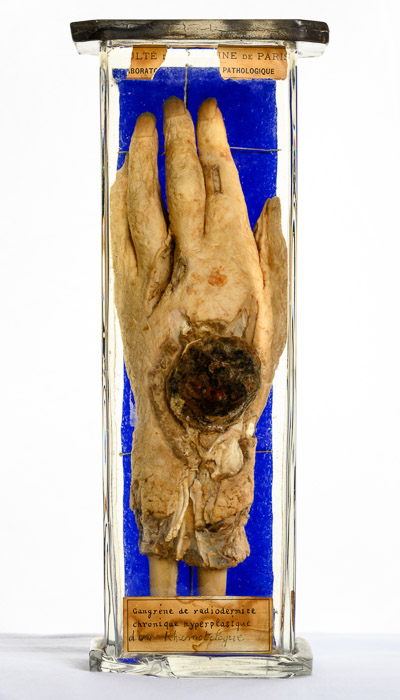[Musealia : Gangrene of the hand of a rheumatologist, a history of radiography through the lens of pathology]
Every month, Sorbonne University invites you to discover an object from its heritage collections. This month, discover the gangrene of the hand of a rheumatologist, a history of radiography through the lens of pathology.
This piece belonging to the Dupuytren collections is a left hand with chronic hyperplastic radiodermatitis gangrene. Collected and prepared at the Salpêtrière Hospital in the early 1910s, this hand now bears witness to an important part of the history of radiography.
In November 1895, German physicist Wilhelm Röntgen (1845-1923) discovered unknown radiation emanating from a Crooks tube (a glass balloon, emptied of air, through which a high-voltage current of electrons flows). This unknown radiation caused a platinum barium cyanide screen near the balloon to luminesce. Röntgen locked himself in his laboratory for several weeks and succeeded in determining the essential characteristics of this radiation. He decided to name them "X" after the term for the unknown in mathematics, and took the first X-ray photograph on 22 December 1895 by inserting the hand of his wife, Berta Röntgen, between a Crookes tube and a photographic plate.
Success was immediate: the first medical imaging departments opened at the end of the century and Wilhelm Röntgen was awarded the Nobel Prize in Physics in 1901. In France, the first radiology laboratory was set up at the Tenon Hospital in 1897 by Antoine Béclère, a pioneer in radiotherapy. X-rays also quickly aroused public interest and radioscopy (observation without taking a photograph) and radiography became fairground attractions: onlookers came to have their hands, feet or handbags x-rayed.
Acquiring international fame, X-rays led industrialist Arthur-Honoré Radiguet (several of whose X-rays are preserved in the Dupuytren Pathological Anatomy Collections) to undertake the construction of large induction coils and, in 1896, to become the first manufacturer and distributor of X-ray equipment in France.
Unfortunately, his experiments cost him dearly. The first operators worked without protection and were therefore constantly subjected to the bombardment of X-rays. The hands, which held the screen or the photographic plate and were therefore unprotected, were in the front line, and cases of radiodermatitis (burns) and cancers multiplied. Radiguet died prematurely in 1905, after having undergone several amputations.
The medical profession became aware of the harmfulness of X-rays, but it was not until the 1920s that the risks associated with ionising radiation were taken into account and radiation protection and therapeutic dosimetry were born. Equipment was then designed to allow remote manipulation, and was equipped with devices to estimate the dose delivered to the patient.
This hand is an example of the history of radiography and the development of medical science, and is also an example of a "wet" or fluid specimen - an anatomical specimen preserved in a conservation solution. This piece, which has a partial flaw in the base of the glass jar and slightly altered labels, is nevertheless in a very good state of preservation. The seal is a historical closing system called a "lutage de Maissiat" (based on rubber in particular) and the blue plate holding the piece adds a singular aesthetic to this hand. Approximately 3800 other pieces keep it company in the dedicated collections.
By Eloïse Quétel, head of the Dupuytren pathological anatomy collections, Heritage Unit, Sorbonne University Library.
Data sheet
- Name/Type : « Gangrène de radiodermite chronique hyperplasique d’un rhumatologue »
- Inventory number : MD.P.2015.0.2584
- Description : height 32.5 cm ; depth 8.5 cm ; lenght 11 cm ; weight : 3141 gr
- Date : March 7, 1911
- Place of storage : Dupuytren pathological anatomy collections
Bibliography
- Röntgen Wilhelm Conrad (1845-1923), Universalis, https://www.universalis.fr/encyclopedie/wilhelm-conrad-rontgen/
- The Nobel Prize in Physics 1901 https://www.nobelprize.org/prizes/physics/1901/summary/
- Guy Pallardy et al., Histoire illustrée de la radiologie, Paris, R. Dacosta, 1989, p. 137
- Jacques Repussard, Alain Rannou, Radioprotection. risques sanitaires liés aux rayonnements ionisants In BOURDILLON François, BRüCKER Gilles, TABUTEAU Didier, Traité de santé
- Charlotte Courtois. Contrôle faisceau et dosimétrie en protonthérapie. Physique Nucléaire Expérimentale [nucl-ex]. Université de Caen, 2011.
Find here all the articles of Musealia.





